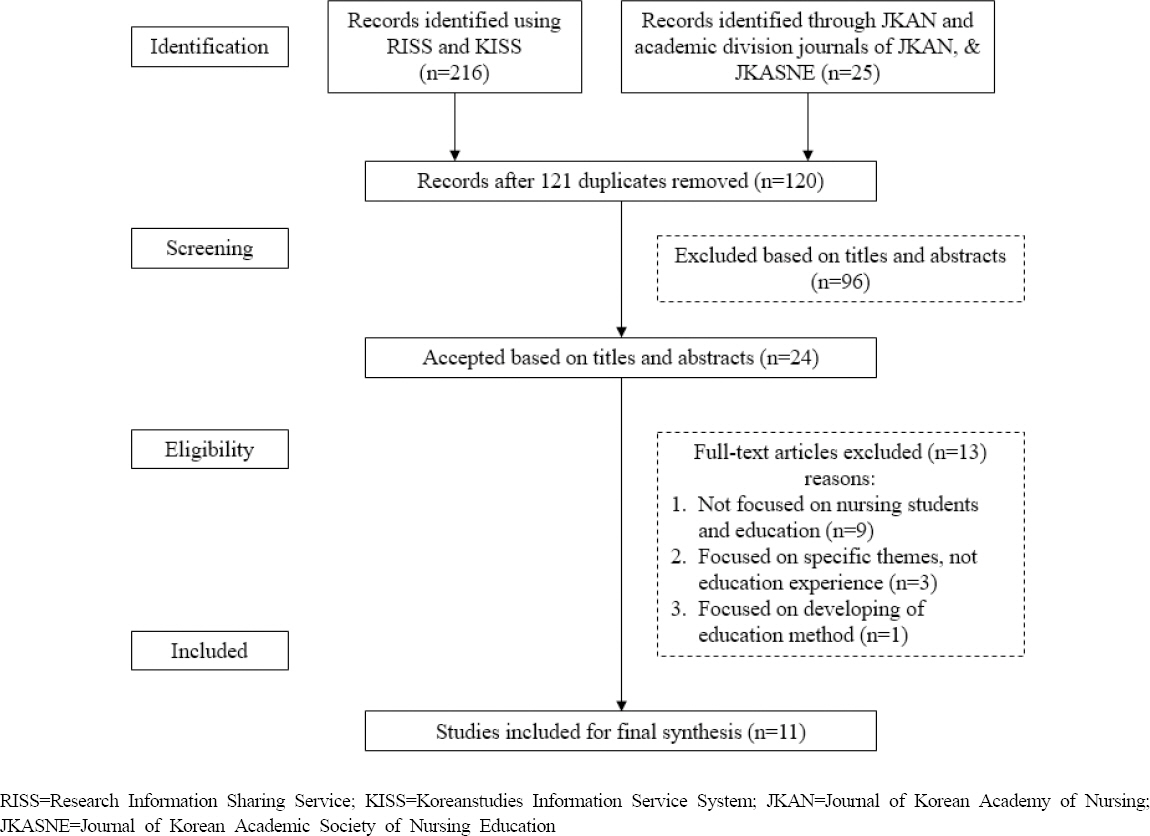Alfaro-Lefevre, R. (2016). Critical thinking, clinical reasoning, and clinical judgment:A practical approach. 6th ed. Philadelphia: Elsevier Health Sciences.
Barrows, H. S. (1994). Practice-based learning:Problem-based learning applied to medical education. Carbondale: Southern Illinois University.
Benner, P, Sutphen, M, Leonard, V, Day, L. (2009). Educating nurses:A call for radical transformation. San Francisco, CA: Jossey-Bass.
Blum, C. A, Parcells, D. A. (2012). Relationship between high-fidelity simulation and patient safety in prelicensure nursing education:A comprehensive review.
Journal of Nursing Education, 51(8):429-435.
https://doi.org/10.3928/01484834-20120523-01


Choi, K. O, Park, Y. M. (2014). The effects of team-based learning on problem solving ability, critical thinking disposition and self-directed learning in undergraduate nursing students.
Journal of East-West Nursing Research, 20(2):154-159.
https://doi.org/10.14370/jewnr.2014.20.2.154


Colaizzi, P. (1978). Psychological research as phenomenologist views it. Valle, R. S, King, MExistential phenomenological alternatives for psychology. New York: Oxford University Press Inc; p. 48-71.
Finnerty, E. P, Chauvin, S, Bonaminio, G, Andrews, M, Carroll, R. G, Pangaro, L. N. (2010). Flexner revisited:The role and value of the basic sciences in medical education.
Academic Medicine, 85(2):349-355.
https://doi.org/10.1097/ACM.0b013e3181c88b09


Guba, E. G, Lincoln, Y. S. (1989). Forth generation evaluation. Newbury Park, CA: Sage Publications.
Huang, Y. M, Pliego, J. F, Henrichs, B, Bowyer, M. W, Siddall, V. J, McGaghie, W. C, et al. (2008). 2007 simulation education summit.
The Journal of the Society for Simulation in Healthcare, 3(3):186-191.
https://doi.org/10.1097/SIH.0b013e3181828156

Jho, H. (2017). The changes of future society and educational environment according to the fourth industrial revolution and the tasks of school science education.
Journal of Korean Elementary Science Education, 36(3):286-301.
https://doi.org/10.15267/KESES.2017.36.3.286

Kang, K. (2019). Study on the analysis of the direction of university education and the teaching capacity of professor in the fourth industrial revolution era:Focused on the paradigm of lifelong education.
Journal of Education and Culture, 25(1):49-82.
https://doi.org/10.24159/joec.2019.25.1.49

Kong, B. H. (2018). Nursing ethics. Seoul: Hynmoonsa.
Krippendorff, K. (2004). Content analysis:An introduction to its methodology. 2nd ed. Beverly Hills: Sage.
Kuiper, R. A, O'Donnell, S, Pesut, D, Turrise, S. (2017). The essentials of clinical reasoning for nurses. Indianapolis: Sigma Theta Tau International.
Li, Y, Wang, X, Zhu, X. R, Zhu, Y. X, Sun, J. (2019). Effectiveness of problem-based learning on the professional communication competencies of nursing students and nurses:A systematic review.
Nurse Education in Practice, 37, 45-55.
https://doi.org/10.1016/j.nepr.2019.04.015


Lincoln, Y. S, Guba, E. G. (1985). Naturalistic inquiry. Newbury Park, CA: Sage Publications.
Lincoln, Y, Guba, E. (1986). But is it rigorous?Trustworthiness and authenticity in naturalistic evaluation.
New Directions for Program Evaluation, 30, 73-84.
https://doi.org/10.1002/ev.1427

McIntosh, C. E, Thomas, C. M, Wilczynski, S, McIntosh, D. E. (2018). Increasing nursing students'knowledge of autism spectrum disorder by using a standardized patient.
Nursing Education Perspectives, 39(1):32-34.
https://doi.org/10.1097/01.nep.0000000000000179


Merisier, S, Larue, C, Boyer, L. (2018). How does questioning influence nursing students'clinical reasoning in problem-based learning?A scoping review.
Nurse Education Today, 65, 108-115.
https://doi.org/10.1016/j.nedt.2018.03.006


Moher, D, Liberati, A, Tetzlaff, J, Altman, D. G. (2009). The PRISMA Group. Preferred reporting items for systematic reviews and meta-analyses:The PRISMA Statement.
PLoS Medicine, 6(7):e1000097.
https://doi.org/10.1371/journal.pmed.1000097



Oh, H. S. (2017). Influence of learning motivation, communication skill, academic self-efficacy on self-directed learning ability in nursing students.
Journal of Digital Convergence, 15(8):311-321.
https://doi.org/10.14400/JDC.2017.15.8.311

Oh, Y. J, Kang, H. Y. (2013). Metacognition, learning flow and problem solving ability in nursing simulation learning.
Journal of Korean Academy of Fundamentals of Nursing, 20(3):239-247.
https://doi.org/10.7739/jkafn.2013.20.3.239


Shin, H, Lee, J. M, Kim, S. J. (2018). An integrative review of smartphone utilization for nursing education among nursing college students in South Korea.
The Journal of Korean Academic Society of Nursing Education, 24(4):376-390.
https://doi.org/10.5977/jkasne.2018.24.4.376


Shin, S, Yang, E. B, Hwang, E, Kim, K, Kim, Y, Jung, D. (2017). Current status and future direction of nursing education for clinical practice.
Korean Medical Education Review, 19(2):76-82.
https://doi.org/10.17496/kmer.2017.19.2.76

Strauss, A, Corbin, J. (1990). Basics of qualitative research:Grounded theory procedures and techniques. Thousand Oak, CA: Sage.
Strauss, A, Corbin, J. (1998). Basic of qualitative research:Techniques and procedures for developing grounded theory. Thousand Oaks, CA: Sage Publications, Inc.
Thorne, S. (2008). Interpretive description. Walnut Creek, CA: Left Coast Press.
Van Kaam, A. (1969). Existential Foundations of Psychology. New York: Doubleday.
Yang, E, Lee, S, Hwang, E. (2008). Teaching medical students in primary and secondary care:A resource book. Seoul: Koonja Publishing.










